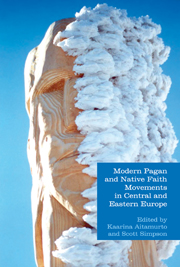Book contents
- Frontmatter
- Contents
- Contributors
- 1 Introduction: Modern Pagan and Native Faith Movements in Central and Eastern Europe
- Part I Overviews
- 2 A Postcolonial Key to Understanding Central and Eastern European Neopaganisms
- 3 Selected Words for Modern Pagan and Native Faith Movements in Central and Eastern Europe
- 4 Romanticism and the Rise of Neopaganism in Nineteenth-Century Central and Eastern Europe: the Polish Case
- 5 Russian Neopaganism: from Ethnic Religion to Racial Violence
- Part I Country Studies
- Part III Thematic Studies
- Bibliography
- Index
4 - Romanticism and the Rise of Neopaganism in Nineteenth-Century Central and Eastern Europe: the Polish Case
from Part I - Overviews
- Frontmatter
- Contents
- Contributors
- 1 Introduction: Modern Pagan and Native Faith Movements in Central and Eastern Europe
- Part I Overviews
- 2 A Postcolonial Key to Understanding Central and Eastern European Neopaganisms
- 3 Selected Words for Modern Pagan and Native Faith Movements in Central and Eastern Europe
- 4 Romanticism and the Rise of Neopaganism in Nineteenth-Century Central and Eastern Europe: the Polish Case
- 5 Russian Neopaganism: from Ethnic Religion to Racial Violence
- Part I Country Studies
- Part III Thematic Studies
- Bibliography
- Index
Summary
The overtly Neopagan movements that proliferated across the region of Central Europe in the first four decades of the twentieth century did so in a way that must have seemed surprising to many observers, like the sudden appearance of mushrooms after the rain. They appear in Germany by 1907, in Lithuania by 1911, in Poland by 1925, in Latvia by 1926, and so on. In historical perspective, however, we can see that the spores of these movements had been sown long before and that their ideas and ambitions had been developing in fertile soil for over a century.
We can roughly divide the stages of development as follows: (1) a stage of “rediscovery” in which Central European nations sought out their nearly forgotten ancient histories and folkways; (2) a stage of “revaluing” in which the ancient became valued alongside the modern, and the “folk” became valued alongside the cosmopolitan; and only then (3) a stage of “re-Paganizing” in which some individuals began to value native Pagan religious practices and ideas more highly than imported Christian ones, and thereby embarked on a journey toward the Neopaganisms found in Europe today. Most of the chapters in this volume are focused exclusively on the third stage of development and what came after. This chapter, however, seeks to trace the development of the first two stages, leading up to the moment when the first Neopagan groups broke ground. While similar processes occurred across the region, this article will focus primarily on the example of the Polish movements.
- Type
- Chapter
- Information
- Publisher: Acumen PublishingPrint publication year: 2013



